Financial Reporting: Context, Framework, and Interpretation
VerifiedAdded on 2021/02/20
|16
|3622
|41
Report
AI Summary
This report provides a comprehensive overview of financial reporting, starting with its context and purpose, and then delving into the conceptual and regulatory frameworks that govern it. It explores the different types of stakeholders involved, detailing their interests and the benefits they derive from financial information. The report further examines how financial reports are utilized to meet company growth and objectives, including an analysis of financial statements. It also covers the presentation of financial statements, including profit and loss, changes in equity, and financial position, with examples. The report concludes with an interpretation of financial statements and a comparison of IAS and IFRS, highlighting the benefits of IFRS and the degree of compliance. The report is based on Price water coopers and the FTSE 100 company.
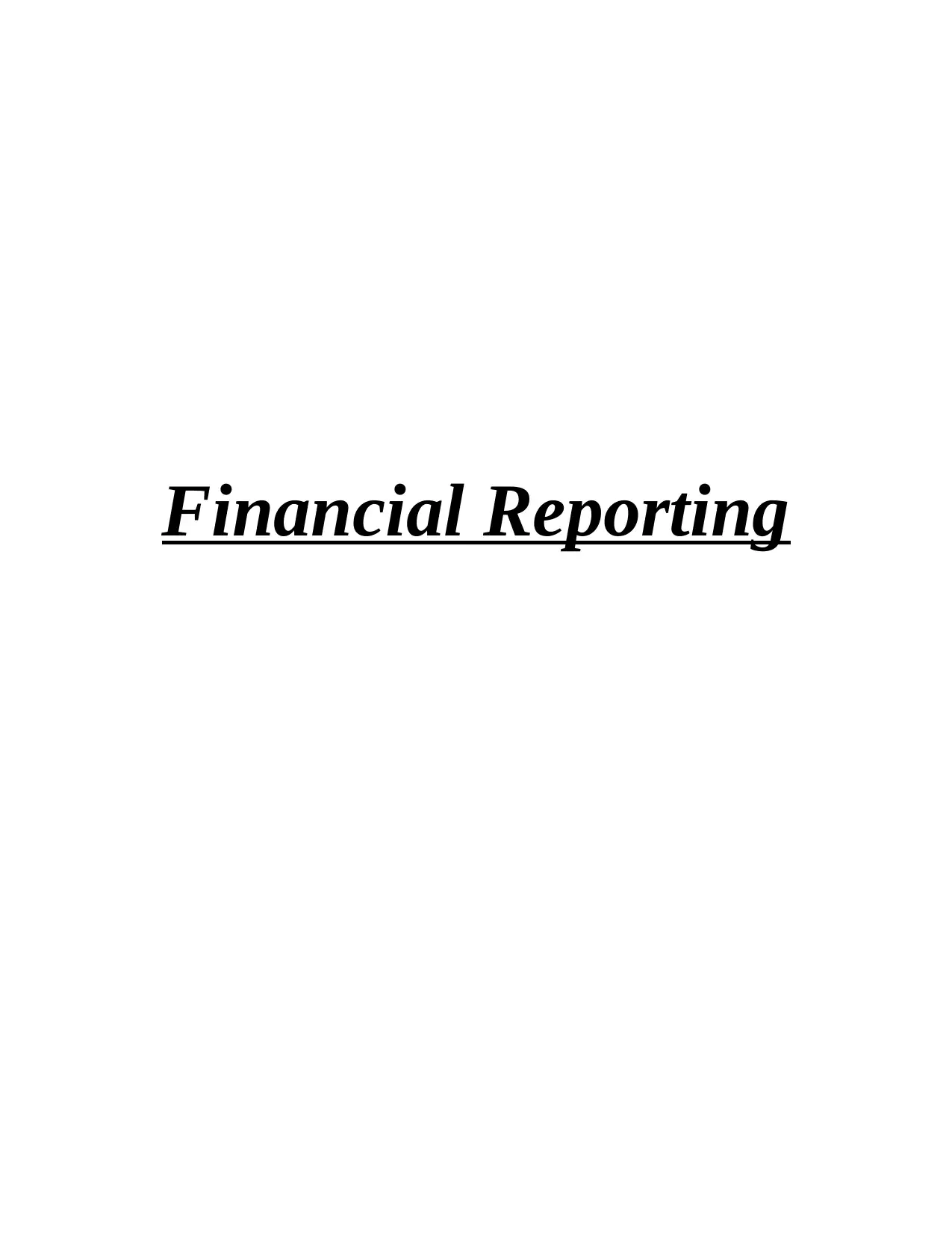
Financial Reporting
Paraphrase This Document
Need a fresh take? Get an instant paraphrase of this document with our AI Paraphraser

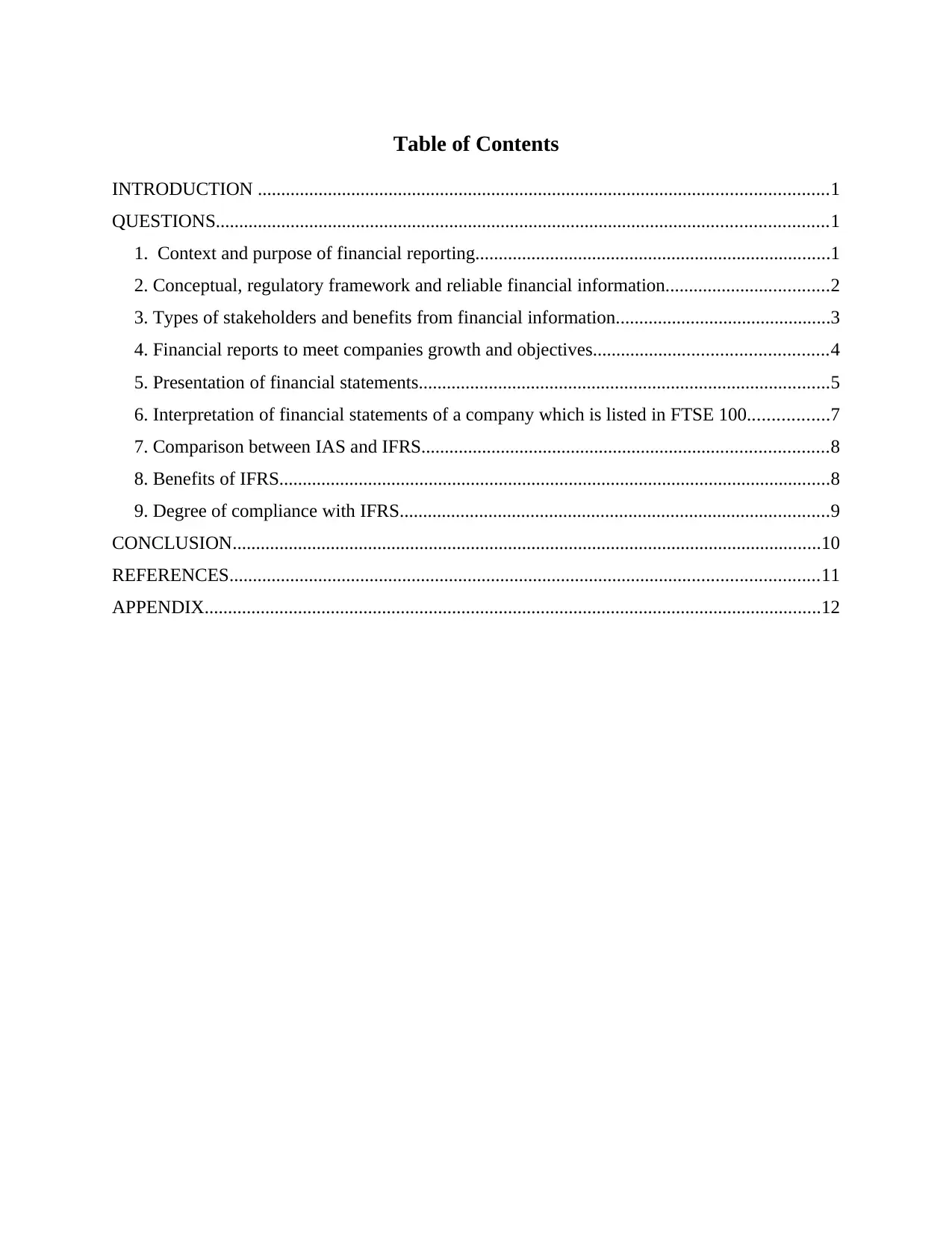
Table of Contents
INTRODUCTION ..........................................................................................................................1
QUESTIONS...................................................................................................................................1
1. Context and purpose of financial reporting............................................................................1
2. Conceptual, regulatory framework and reliable financial information...................................2
3. Types of stakeholders and benefits from financial information..............................................3
4. Financial reports to meet companies growth and objectives..................................................4
5. Presentation of financial statements........................................................................................5
6. Interpretation of financial statements of a company which is listed in FTSE 100.................7
7. Comparison between IAS and IFRS.......................................................................................8
8. Benefits of IFRS......................................................................................................................8
9. Degree of compliance with IFRS............................................................................................9
CONCLUSION..............................................................................................................................10
REFERENCES..............................................................................................................................11
APPENDIX....................................................................................................................................12
INTRODUCTION ..........................................................................................................................1
QUESTIONS...................................................................................................................................1
1. Context and purpose of financial reporting............................................................................1
2. Conceptual, regulatory framework and reliable financial information...................................2
3. Types of stakeholders and benefits from financial information..............................................3
4. Financial reports to meet companies growth and objectives..................................................4
5. Presentation of financial statements........................................................................................5
6. Interpretation of financial statements of a company which is listed in FTSE 100.................7
7. Comparison between IAS and IFRS.......................................................................................8
8. Benefits of IFRS......................................................................................................................8
9. Degree of compliance with IFRS............................................................................................9
CONCLUSION..............................................................................................................................10
REFERENCES..............................................................................................................................11
APPENDIX....................................................................................................................................12
⊘ This is a preview!⊘
Do you want full access?
Subscribe today to unlock all pages.

Trusted by 1+ million students worldwide

INTRODUCTION
Financial reporting, is defined as the wider process that includes the disclosure of useful
financial information through preparing and presenting financial statements to specific manager
and general public (Krishnan and Zhang, 2014). There are mainly two main purpose of financial
reporting, it helps accountant to engage in decision making mainly developing strategies to attain
company objective. Secondly, it gives crucial information related with financial status and
strength of firm to stakeholder that includes shareholder, investors, customer and regulator of
government. This report is based on Price water coopers have been selected which is one of the
large accountancy firm which is located in London UK.
In this report, context and purpose of financial reporting, interpretation of financial
statement of selected company from FTSE 100 is selected. Report also evaluate importance of
reporting standard and various theoretical model and concepts, it also evaluate international
differences in financial reporting.
QUESTIONS
1. Context and purpose of financial reporting.
The technique of demonstrating the firm's economic data in the manner of accounts is
known as financial reporting. The main goal of generating the financial statements would be to
remind interested parties regarding the current company's financial situation. As per the
International Accounting Standard Board (IASB), the primary goal of creating financial
statement is to generate valuable information that support to analyse the present financial
situation so that appropriate changes could be produced to enhance the business's position. It was
analysed that financial reporting comprises of a method that might help to track information
relevant to financing so impactful management or control of a an entity can be carried out
(Norwani, Zam and Chek, 2011). In addition, it is observed that International accounting
standard board mainly states that Price water coopers needs to prepare financial statement in
order to give stakeholders with the appropriate information directly relevant to company
resources. Different statement finally display genuine financial situation that can help to attract
new investments or expand current investors' value by shareholder.
Financial reporting is very essential to everyone involved in the activities and tasks of
business firm. There are number of objective of financial reporting that are discussed below:
1
Financial reporting, is defined as the wider process that includes the disclosure of useful
financial information through preparing and presenting financial statements to specific manager
and general public (Krishnan and Zhang, 2014). There are mainly two main purpose of financial
reporting, it helps accountant to engage in decision making mainly developing strategies to attain
company objective. Secondly, it gives crucial information related with financial status and
strength of firm to stakeholder that includes shareholder, investors, customer and regulator of
government. This report is based on Price water coopers have been selected which is one of the
large accountancy firm which is located in London UK.
In this report, context and purpose of financial reporting, interpretation of financial
statement of selected company from FTSE 100 is selected. Report also evaluate importance of
reporting standard and various theoretical model and concepts, it also evaluate international
differences in financial reporting.
QUESTIONS
1. Context and purpose of financial reporting.
The technique of demonstrating the firm's economic data in the manner of accounts is
known as financial reporting. The main goal of generating the financial statements would be to
remind interested parties regarding the current company's financial situation. As per the
International Accounting Standard Board (IASB), the primary goal of creating financial
statement is to generate valuable information that support to analyse the present financial
situation so that appropriate changes could be produced to enhance the business's position. It was
analysed that financial reporting comprises of a method that might help to track information
relevant to financing so impactful management or control of a an entity can be carried out
(Norwani, Zam and Chek, 2011). In addition, it is observed that International accounting
standard board mainly states that Price water coopers needs to prepare financial statement in
order to give stakeholders with the appropriate information directly relevant to company
resources. Different statement finally display genuine financial situation that can help to attract
new investments or expand current investors' value by shareholder.
Financial reporting is very essential to everyone involved in the activities and tasks of
business firm. There are number of objective of financial reporting that are discussed below:
1
Paraphrase This Document
Need a fresh take? Get an instant paraphrase of this document with our AI Paraphraser
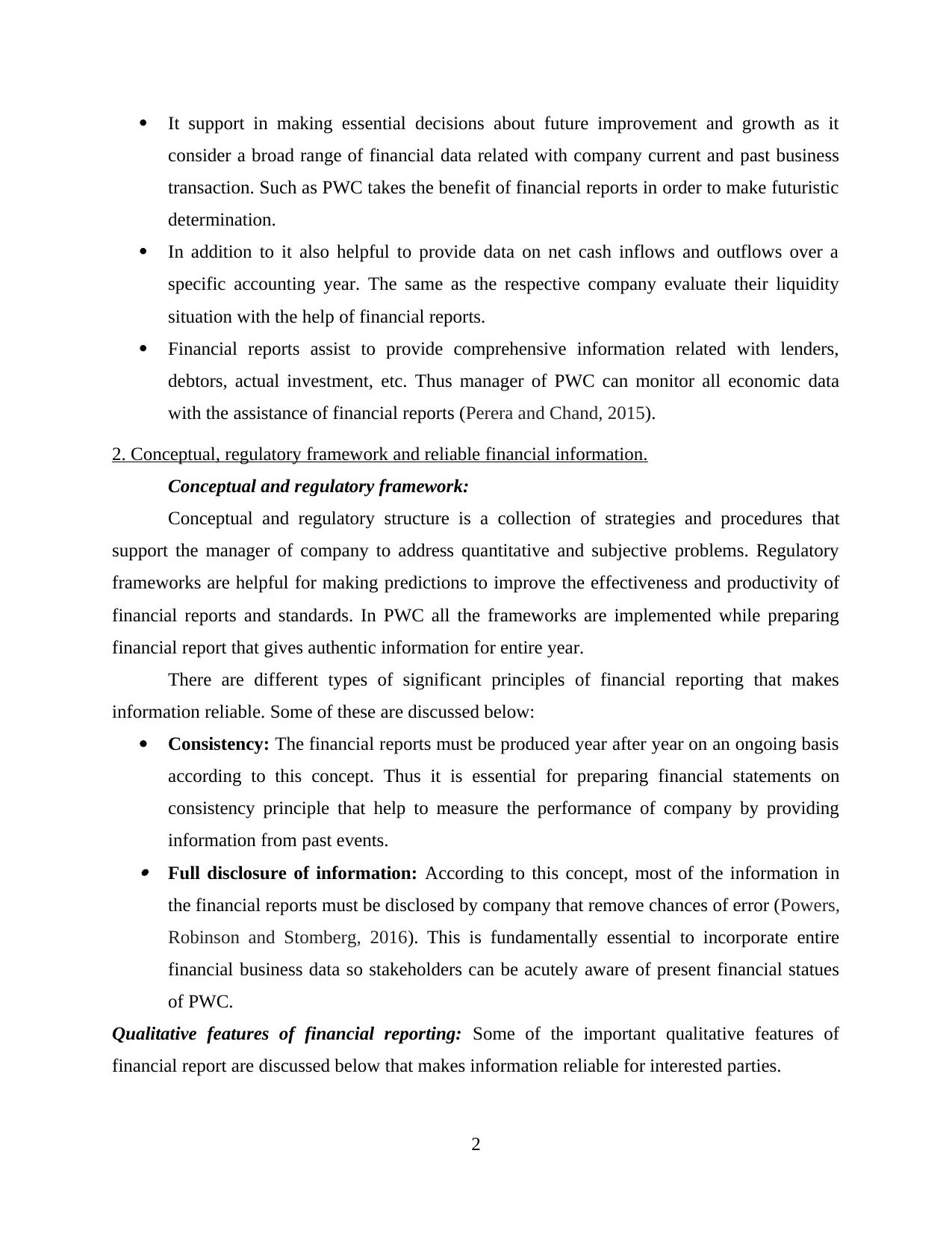
It support in making essential decisions about future improvement and growth as it
consider a broad range of financial data related with company current and past business
transaction. Such as PWC takes the benefit of financial reports in order to make futuristic
determination.
In addition to it also helpful to provide data on net cash inflows and outflows over a
specific accounting year. The same as the respective company evaluate their liquidity
situation with the help of financial reports.
Financial reports assist to provide comprehensive information related with lenders,
debtors, actual investment, etc. Thus manager of PWC can monitor all economic data
with the assistance of financial reports (Perera and Chand, 2015).
2. Conceptual, regulatory framework and reliable financial information.
Conceptual and regulatory framework:
Conceptual and regulatory structure is a collection of strategies and procedures that
support the manager of company to address quantitative and subjective problems. Regulatory
frameworks are helpful for making predictions to improve the effectiveness and productivity of
financial reports and standards. In PWC all the frameworks are implemented while preparing
financial report that gives authentic information for entire year.
There are different types of significant principles of financial reporting that makes
information reliable. Some of these are discussed below:
Consistency: The financial reports must be produced year after year on an ongoing basis
according to this concept. Thus it is essential for preparing financial statements on
consistency principle that help to measure the performance of company by providing
information from past events. Full disclosure of information: According to this concept, most of the information in
the financial reports must be disclosed by company that remove chances of error (Powers,
Robinson and Stomberg, 2016). This is fundamentally essential to incorporate entire
financial business data so stakeholders can be acutely aware of present financial statues
of PWC.
Qualitative features of financial reporting: Some of the important qualitative features of
financial report are discussed below that makes information reliable for interested parties.
2
consider a broad range of financial data related with company current and past business
transaction. Such as PWC takes the benefit of financial reports in order to make futuristic
determination.
In addition to it also helpful to provide data on net cash inflows and outflows over a
specific accounting year. The same as the respective company evaluate their liquidity
situation with the help of financial reports.
Financial reports assist to provide comprehensive information related with lenders,
debtors, actual investment, etc. Thus manager of PWC can monitor all economic data
with the assistance of financial reports (Perera and Chand, 2015).
2. Conceptual, regulatory framework and reliable financial information.
Conceptual and regulatory framework:
Conceptual and regulatory structure is a collection of strategies and procedures that
support the manager of company to address quantitative and subjective problems. Regulatory
frameworks are helpful for making predictions to improve the effectiveness and productivity of
financial reports and standards. In PWC all the frameworks are implemented while preparing
financial report that gives authentic information for entire year.
There are different types of significant principles of financial reporting that makes
information reliable. Some of these are discussed below:
Consistency: The financial reports must be produced year after year on an ongoing basis
according to this concept. Thus it is essential for preparing financial statements on
consistency principle that help to measure the performance of company by providing
information from past events. Full disclosure of information: According to this concept, most of the information in
the financial reports must be disclosed by company that remove chances of error (Powers,
Robinson and Stomberg, 2016). This is fundamentally essential to incorporate entire
financial business data so stakeholders can be acutely aware of present financial statues
of PWC.
Qualitative features of financial reporting: Some of the important qualitative features of
financial report are discussed below that makes information reliable for interested parties.
2
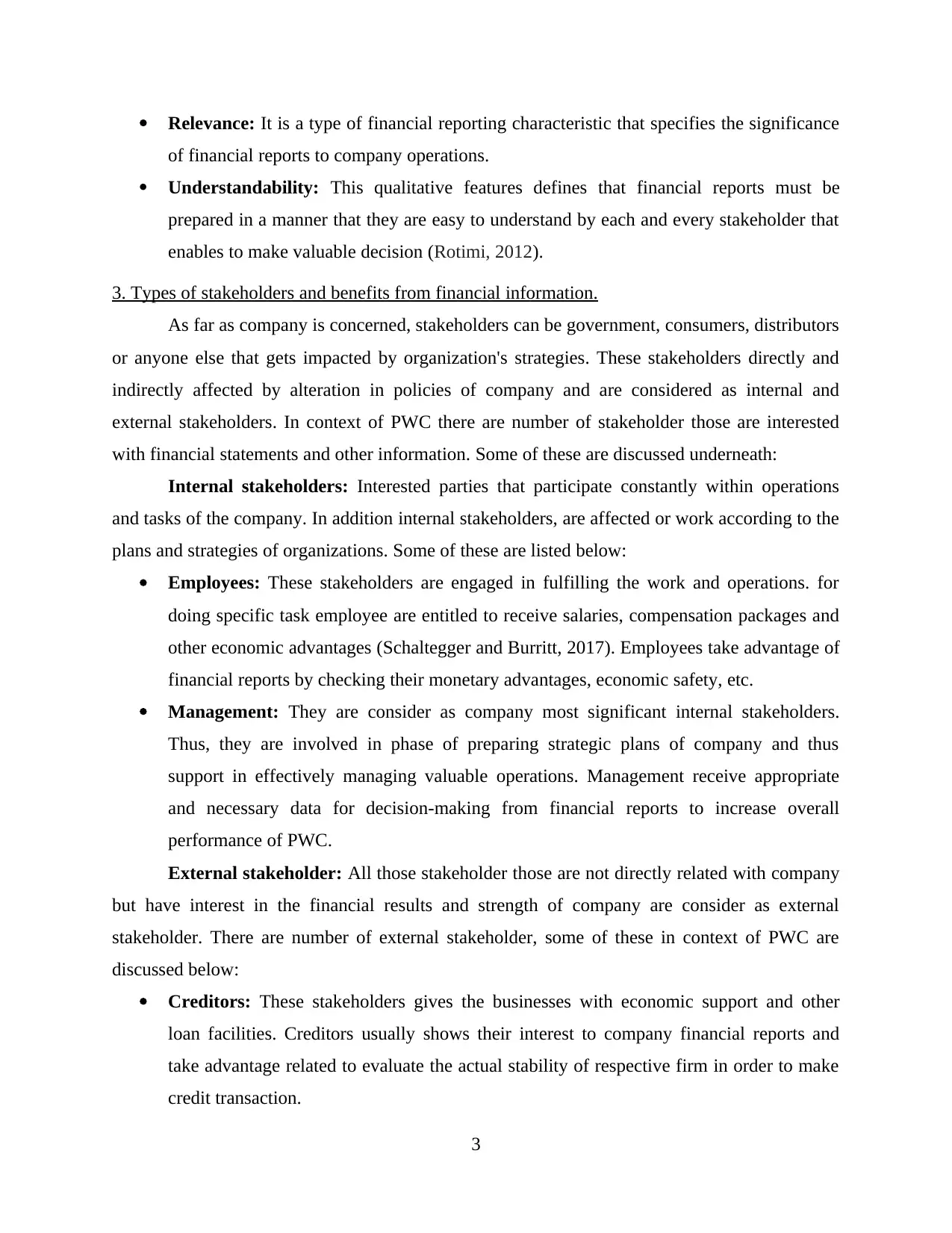
Relevance: It is a type of financial reporting characteristic that specifies the significance
of financial reports to company operations.
Understandability: This qualitative features defines that financial reports must be
prepared in a manner that they are easy to understand by each and every stakeholder that
enables to make valuable decision (Rotimi, 2012).
3. Types of stakeholders and benefits from financial information.
As far as company is concerned, stakeholders can be government, consumers, distributors
or anyone else that gets impacted by organization's strategies. These stakeholders directly and
indirectly affected by alteration in policies of company and are considered as internal and
external stakeholders. In context of PWC there are number of stakeholder those are interested
with financial statements and other information. Some of these are discussed underneath:
Internal stakeholders: Interested parties that participate constantly within operations
and tasks of the company. In addition internal stakeholders, are affected or work according to the
plans and strategies of organizations. Some of these are listed below:
Employees: These stakeholders are engaged in fulfilling the work and operations. for
doing specific task employee are entitled to receive salaries, compensation packages and
other economic advantages (Schaltegger and Burritt, 2017). Employees take advantage of
financial reports by checking their monetary advantages, economic safety, etc.
Management: They are consider as company most significant internal stakeholders.
Thus, they are involved in phase of preparing strategic plans of company and thus
support in effectively managing valuable operations. Management receive appropriate
and necessary data for decision-making from financial reports to increase overall
performance of PWC.
External stakeholder: All those stakeholder those are not directly related with company
but have interest in the financial results and strength of company are consider as external
stakeholder. There are number of external stakeholder, some of these in context of PWC are
discussed below:
Creditors: These stakeholders gives the businesses with economic support and other
loan facilities. Creditors usually shows their interest to company financial reports and
take advantage related to evaluate the actual stability of respective firm in order to make
credit transaction.
3
of financial reports to company operations.
Understandability: This qualitative features defines that financial reports must be
prepared in a manner that they are easy to understand by each and every stakeholder that
enables to make valuable decision (Rotimi, 2012).
3. Types of stakeholders and benefits from financial information.
As far as company is concerned, stakeholders can be government, consumers, distributors
or anyone else that gets impacted by organization's strategies. These stakeholders directly and
indirectly affected by alteration in policies of company and are considered as internal and
external stakeholders. In context of PWC there are number of stakeholder those are interested
with financial statements and other information. Some of these are discussed underneath:
Internal stakeholders: Interested parties that participate constantly within operations
and tasks of the company. In addition internal stakeholders, are affected or work according to the
plans and strategies of organizations. Some of these are listed below:
Employees: These stakeholders are engaged in fulfilling the work and operations. for
doing specific task employee are entitled to receive salaries, compensation packages and
other economic advantages (Schaltegger and Burritt, 2017). Employees take advantage of
financial reports by checking their monetary advantages, economic safety, etc.
Management: They are consider as company most significant internal stakeholders.
Thus, they are involved in phase of preparing strategic plans of company and thus
support in effectively managing valuable operations. Management receive appropriate
and necessary data for decision-making from financial reports to increase overall
performance of PWC.
External stakeholder: All those stakeholder those are not directly related with company
but have interest in the financial results and strength of company are consider as external
stakeholder. There are number of external stakeholder, some of these in context of PWC are
discussed below:
Creditors: These stakeholders gives the businesses with economic support and other
loan facilities. Creditors usually shows their interest to company financial reports and
take advantage related to evaluate the actual stability of respective firm in order to make
credit transaction.
3
⊘ This is a preview!⊘
Do you want full access?
Subscribe today to unlock all pages.

Trusted by 1+ million students worldwide
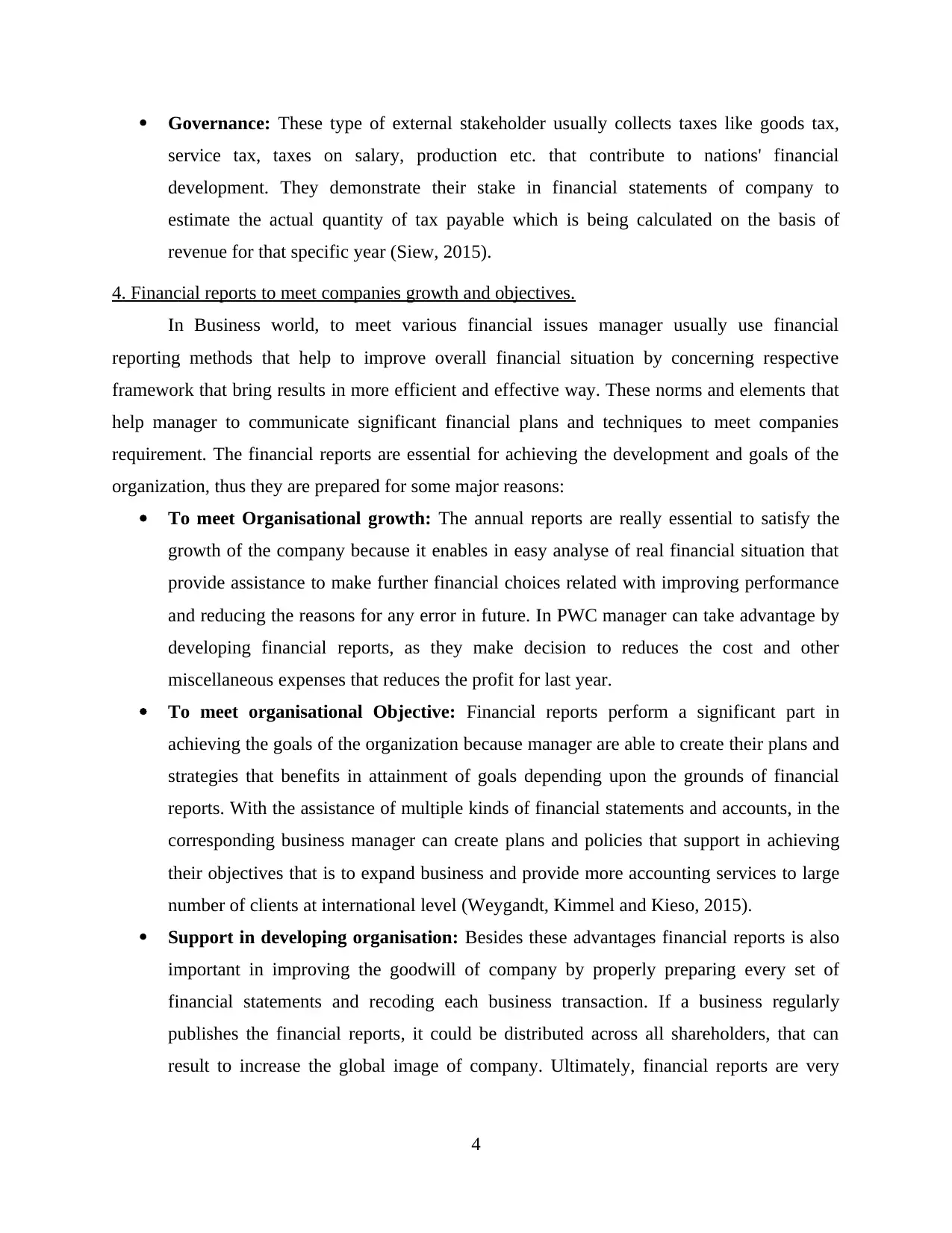
Governance: These type of external stakeholder usually collects taxes like goods tax,
service tax, taxes on salary, production etc. that contribute to nations' financial
development. They demonstrate their stake in financial statements of company to
estimate the actual quantity of tax payable which is being calculated on the basis of
revenue for that specific year (Siew, 2015).
4. Financial reports to meet companies growth and objectives.
In Business world, to meet various financial issues manager usually use financial
reporting methods that help to improve overall financial situation by concerning respective
framework that bring results in more efficient and effective way. These norms and elements that
help manager to communicate significant financial plans and techniques to meet companies
requirement. The financial reports are essential for achieving the development and goals of the
organization, thus they are prepared for some major reasons:
To meet Organisational growth: The annual reports are really essential to satisfy the
growth of the company because it enables in easy analyse of real financial situation that
provide assistance to make further financial choices related with improving performance
and reducing the reasons for any error in future. In PWC manager can take advantage by
developing financial reports, as they make decision to reduces the cost and other
miscellaneous expenses that reduces the profit for last year.
To meet organisational Objective: Financial reports perform a significant part in
achieving the goals of the organization because manager are able to create their plans and
strategies that benefits in attainment of goals depending upon the grounds of financial
reports. With the assistance of multiple kinds of financial statements and accounts, in the
corresponding business manager can create plans and policies that support in achieving
their objectives that is to expand business and provide more accounting services to large
number of clients at international level (Weygandt, Kimmel and Kieso, 2015).
Support in developing organisation: Besides these advantages financial reports is also
important in improving the goodwill of company by properly preparing every set of
financial statements and recoding each business transaction. If a business regularly
publishes the financial reports, it could be distributed across all shareholders, that can
result to increase the global image of company. Ultimately, financial reports are very
4
service tax, taxes on salary, production etc. that contribute to nations' financial
development. They demonstrate their stake in financial statements of company to
estimate the actual quantity of tax payable which is being calculated on the basis of
revenue for that specific year (Siew, 2015).
4. Financial reports to meet companies growth and objectives.
In Business world, to meet various financial issues manager usually use financial
reporting methods that help to improve overall financial situation by concerning respective
framework that bring results in more efficient and effective way. These norms and elements that
help manager to communicate significant financial plans and techniques to meet companies
requirement. The financial reports are essential for achieving the development and goals of the
organization, thus they are prepared for some major reasons:
To meet Organisational growth: The annual reports are really essential to satisfy the
growth of the company because it enables in easy analyse of real financial situation that
provide assistance to make further financial choices related with improving performance
and reducing the reasons for any error in future. In PWC manager can take advantage by
developing financial reports, as they make decision to reduces the cost and other
miscellaneous expenses that reduces the profit for last year.
To meet organisational Objective: Financial reports perform a significant part in
achieving the goals of the organization because manager are able to create their plans and
strategies that benefits in attainment of goals depending upon the grounds of financial
reports. With the assistance of multiple kinds of financial statements and accounts, in the
corresponding business manager can create plans and policies that support in achieving
their objectives that is to expand business and provide more accounting services to large
number of clients at international level (Weygandt, Kimmel and Kieso, 2015).
Support in developing organisation: Besides these advantages financial reports is also
important in improving the goodwill of company by properly preparing every set of
financial statements and recoding each business transaction. If a business regularly
publishes the financial reports, it could be distributed across all shareholders, that can
result to increase the global image of company. Ultimately, financial reports are very
4
Paraphrase This Document
Need a fresh take? Get an instant paraphrase of this document with our AI Paraphraser
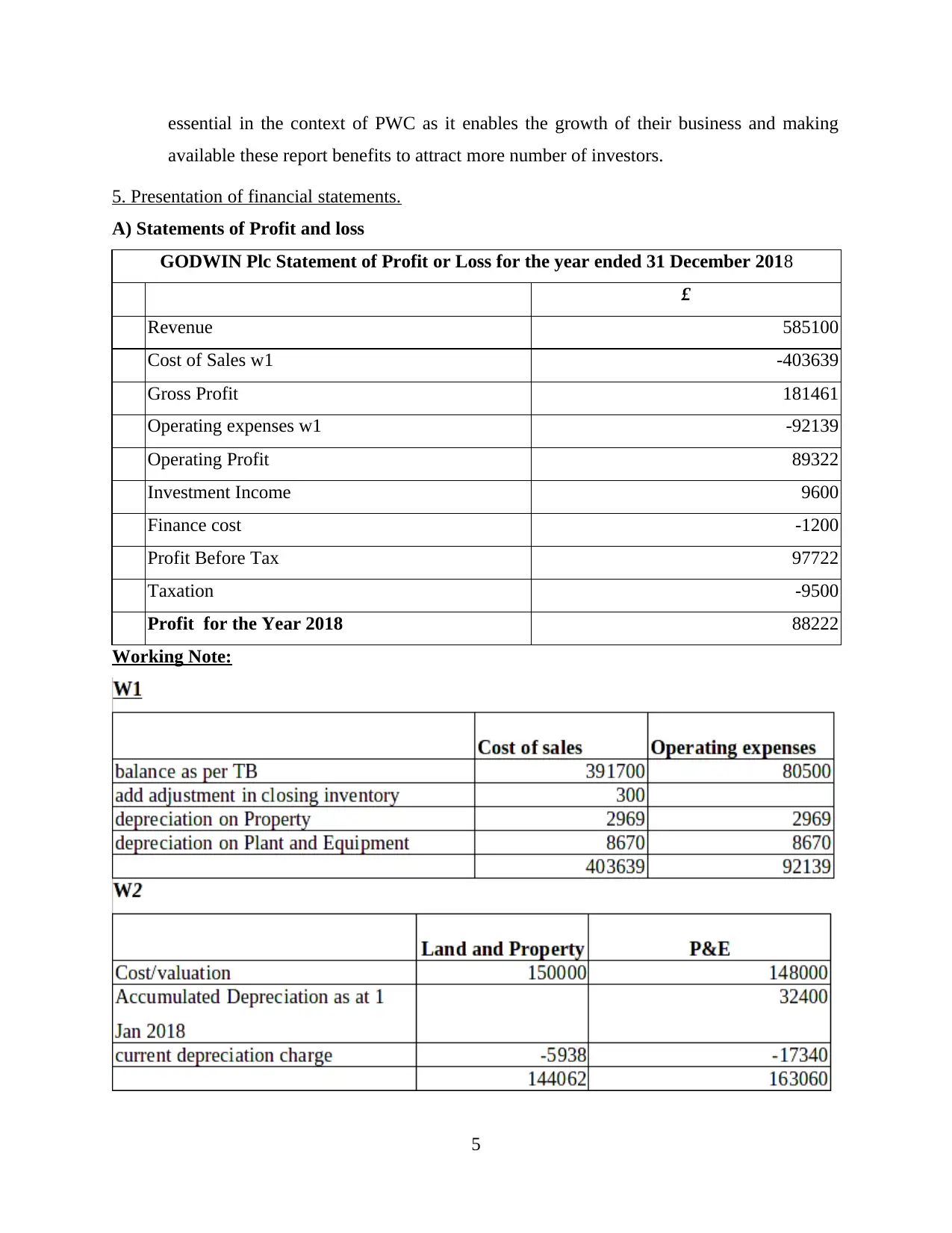
essential in the context of PWC as it enables the growth of their business and making
available these report benefits to attract more number of investors.
5. Presentation of financial statements.
A) Statements of Profit and loss
GODWIN Plc Statement of Profit or Loss for the year ended 31 December 2018
£
Revenue 585100
Cost of Sales w1 -403639
Gross Profit 181461
Operating expenses w1 -92139
Operating Profit 89322
Investment Income 9600
Finance cost -1200
Profit Before Tax 97722
Taxation -9500
Profit for the Year 2018 88222
Working Note:
5
available these report benefits to attract more number of investors.
5. Presentation of financial statements.
A) Statements of Profit and loss
GODWIN Plc Statement of Profit or Loss for the year ended 31 December 2018
£
Revenue 585100
Cost of Sales w1 -403639
Gross Profit 181461
Operating expenses w1 -92139
Operating Profit 89322
Investment Income 9600
Finance cost -1200
Profit Before Tax 97722
Taxation -9500
Profit for the Year 2018 88222
Working Note:
5
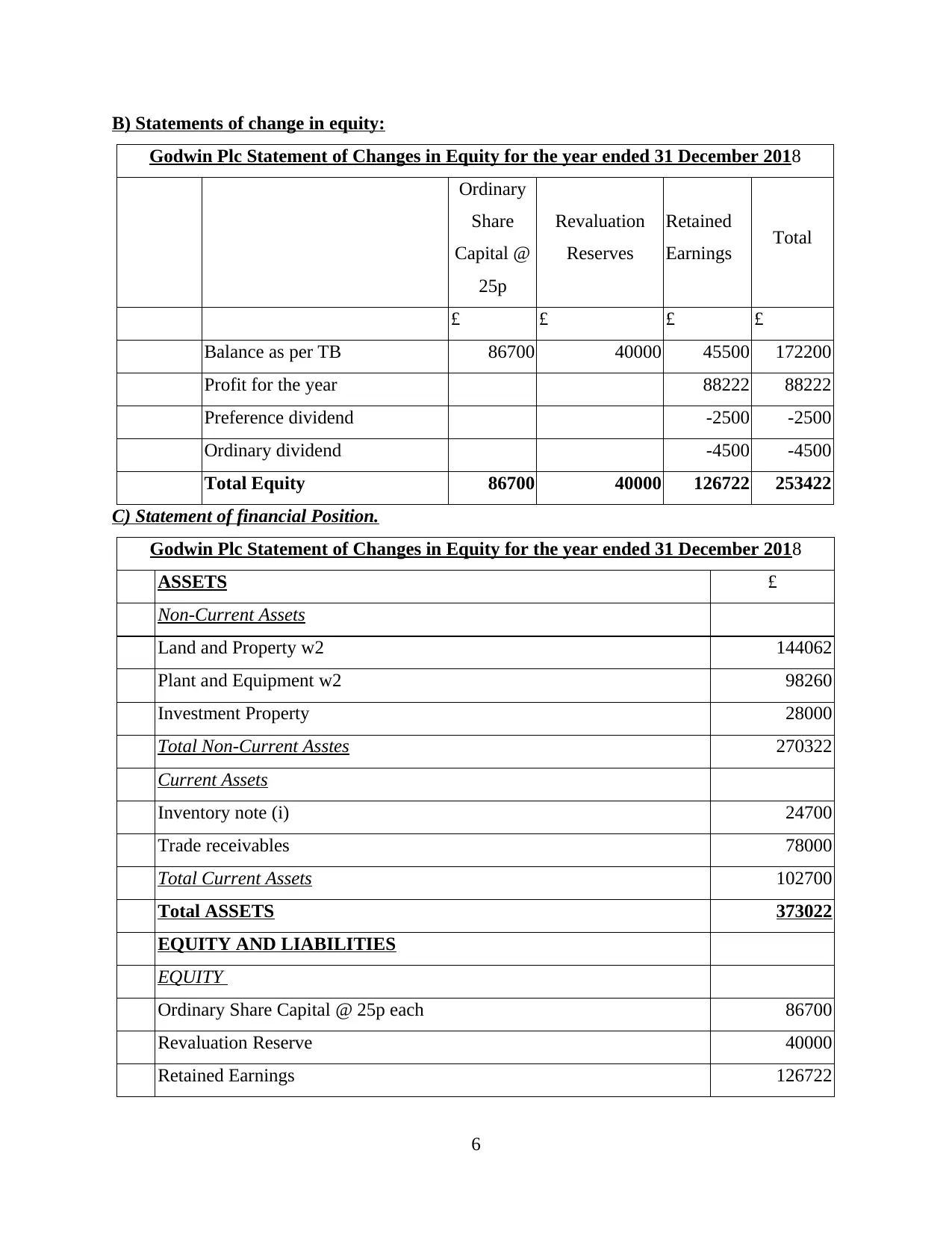
B) Statements of change in equity:
Godwin Plc Statement of Changes in Equity for the year ended 31 December 2018
Ordinary
Share
Capital @
25p
Revaluation
Reserves
Retained
Earnings Total
£ £ £ £
Balance as per TB 86700 40000 45500 172200
Profit for the year 88222 88222
Preference dividend -2500 -2500
Ordinary dividend -4500 -4500
Total Equity 86700 40000 126722 253422
C) Statement of financial Position.
Godwin Plc Statement of Changes in Equity for the year ended 31 December 2018
ASSETS £
Non-Current Assets
Land and Property w2 144062
Plant and Equipment w2 98260
Investment Property 28000
Total Non-Current Asstes 270322
Current Assets
Inventory note (i) 24700
Trade receivables 78000
Total Current Assets 102700
Total ASSETS 373022
EQUITY AND LIABILITIES
EQUITY
Ordinary Share Capital @ 25p each 86700
Revaluation Reserve 40000
Retained Earnings 126722
6
Godwin Plc Statement of Changes in Equity for the year ended 31 December 2018
Ordinary
Share
Capital @
25p
Revaluation
Reserves
Retained
Earnings Total
£ £ £ £
Balance as per TB 86700 40000 45500 172200
Profit for the year 88222 88222
Preference dividend -2500 -2500
Ordinary dividend -4500 -4500
Total Equity 86700 40000 126722 253422
C) Statement of financial Position.
Godwin Plc Statement of Changes in Equity for the year ended 31 December 2018
ASSETS £
Non-Current Assets
Land and Property w2 144062
Plant and Equipment w2 98260
Investment Property 28000
Total Non-Current Asstes 270322
Current Assets
Inventory note (i) 24700
Trade receivables 78000
Total Current Assets 102700
Total ASSETS 373022
EQUITY AND LIABILITIES
EQUITY
Ordinary Share Capital @ 25p each 86700
Revaluation Reserve 40000
Retained Earnings 126722
6
⊘ This is a preview!⊘
Do you want full access?
Subscribe today to unlock all pages.

Trusted by 1+ million students worldwide
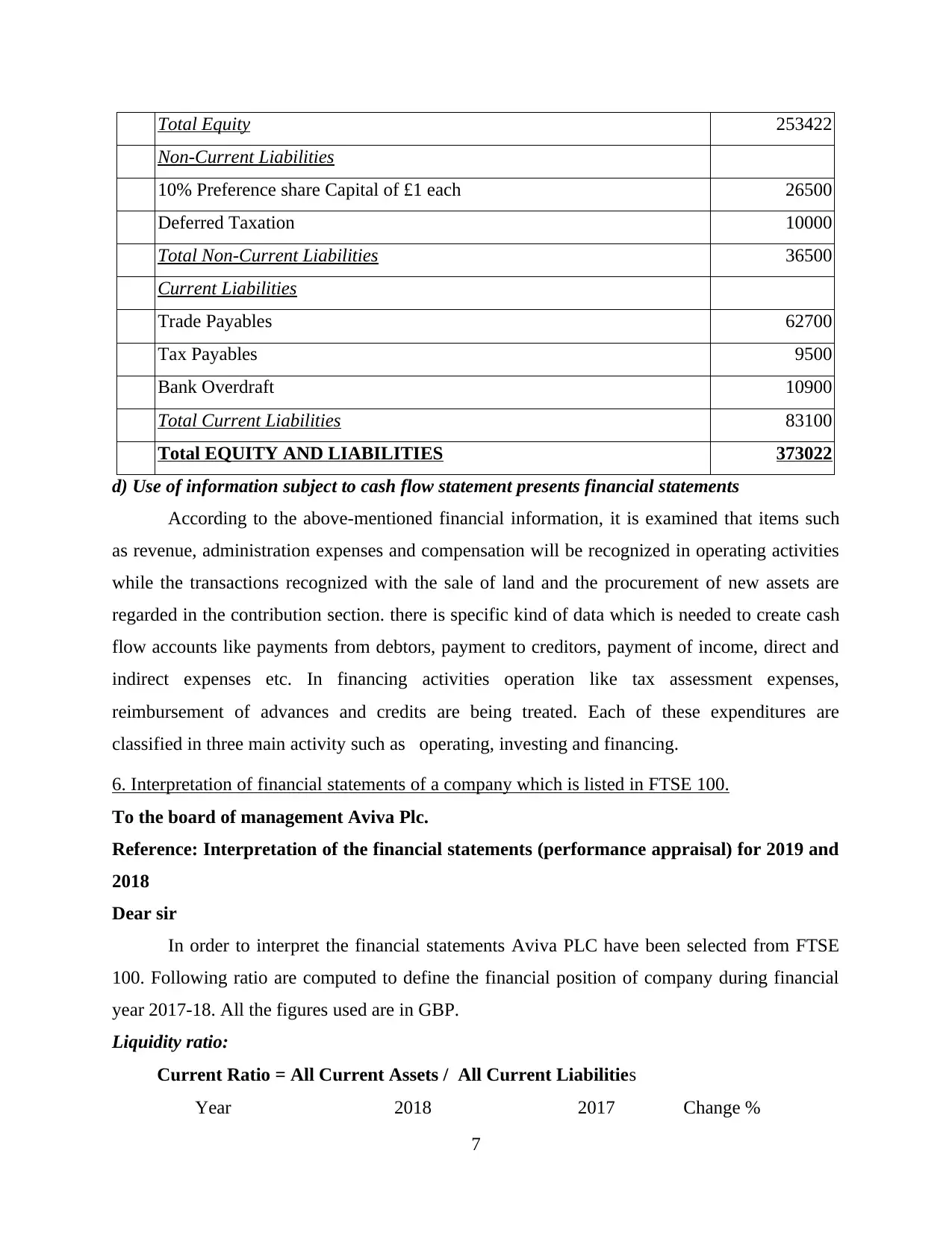
Total Equity 253422
Non-Current Liabilities
10% Preference share Capital of £1 each 26500
Deferred Taxation 10000
Total Non-Current Liabilities 36500
Current Liabilities
Trade Payables 62700
Tax Payables 9500
Bank Overdraft 10900
Total Current Liabilities 83100
Total EQUITY AND LIABILITIES 373022
d) Use of information subject to cash flow statement presents financial statements
According to the above-mentioned financial information, it is examined that items such
as revenue, administration expenses and compensation will be recognized in operating activities
while the transactions recognized with the sale of land and the procurement of new assets are
regarded in the contribution section. there is specific kind of data which is needed to create cash
flow accounts like payments from debtors, payment to creditors, payment of income, direct and
indirect expenses etc. In financing activities operation like tax assessment expenses,
reimbursement of advances and credits are being treated. Each of these expenditures are
classified in three main activity such as operating, investing and financing.
6. Interpretation of financial statements of a company which is listed in FTSE 100.
To the board of management Aviva Plc.
Reference: Interpretation of the financial statements (performance appraisal) for 2019 and
2018
Dear sir
In order to interpret the financial statements Aviva PLC have been selected from FTSE
100. Following ratio are computed to define the financial position of company during financial
year 2017-18. All the figures used are in GBP.
Liquidity ratio:
Current Ratio = All Current Assets / All Current Liabilities
Year 2018 2017 Change %
7
Non-Current Liabilities
10% Preference share Capital of £1 each 26500
Deferred Taxation 10000
Total Non-Current Liabilities 36500
Current Liabilities
Trade Payables 62700
Tax Payables 9500
Bank Overdraft 10900
Total Current Liabilities 83100
Total EQUITY AND LIABILITIES 373022
d) Use of information subject to cash flow statement presents financial statements
According to the above-mentioned financial information, it is examined that items such
as revenue, administration expenses and compensation will be recognized in operating activities
while the transactions recognized with the sale of land and the procurement of new assets are
regarded in the contribution section. there is specific kind of data which is needed to create cash
flow accounts like payments from debtors, payment to creditors, payment of income, direct and
indirect expenses etc. In financing activities operation like tax assessment expenses,
reimbursement of advances and credits are being treated. Each of these expenditures are
classified in three main activity such as operating, investing and financing.
6. Interpretation of financial statements of a company which is listed in FTSE 100.
To the board of management Aviva Plc.
Reference: Interpretation of the financial statements (performance appraisal) for 2019 and
2018
Dear sir
In order to interpret the financial statements Aviva PLC have been selected from FTSE
100. Following ratio are computed to define the financial position of company during financial
year 2017-18. All the figures used are in GBP.
Liquidity ratio:
Current Ratio = All Current Assets / All Current Liabilities
Year 2018 2017 Change %
7
Paraphrase This Document
Need a fresh take? Get an instant paraphrase of this document with our AI Paraphraser
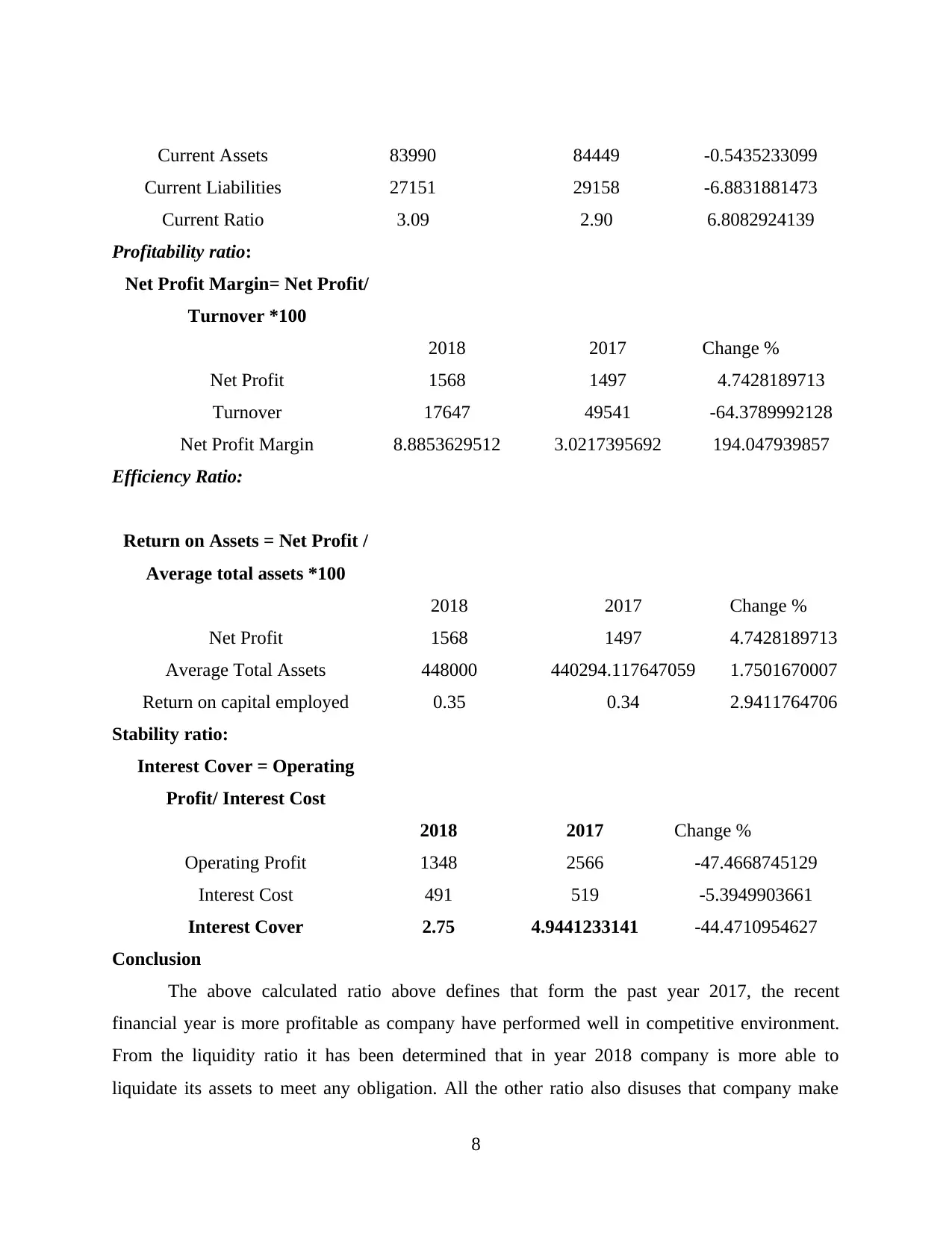
Current Assets 83990 84449 -0.5435233099
Current Liabilities 27151 29158 -6.8831881473
Current Ratio 3.09 2.90 6.8082924139
Profitability ratio:
Net Profit Margin= Net Profit/
Turnover *100
2018 2017 Change %
Net Profit 1568 1497 4.7428189713
Turnover 17647 49541 -64.3789992128
Net Profit Margin 8.8853629512 3.0217395692 194.047939857
Efficiency Ratio:
Return on Assets = Net Profit /
Average total assets *100
2018 2017 Change %
Net Profit 1568 1497 4.7428189713
Average Total Assets 448000 440294.117647059 1.7501670007
Return on capital employed 0.35 0.34 2.9411764706
Stability ratio:
Interest Cover = Operating
Profit/ Interest Cost
2018 2017 Change %
Operating Profit 1348 2566 -47.4668745129
Interest Cost 491 519 -5.3949903661
Interest Cover 2.75 4.9441233141 -44.4710954627
Conclusion
The above calculated ratio above defines that form the past year 2017, the recent
financial year is more profitable as company have performed well in competitive environment.
From the liquidity ratio it has been determined that in year 2018 company is more able to
liquidate its assets to meet any obligation. All the other ratio also disuses that company make
8
Current Liabilities 27151 29158 -6.8831881473
Current Ratio 3.09 2.90 6.8082924139
Profitability ratio:
Net Profit Margin= Net Profit/
Turnover *100
2018 2017 Change %
Net Profit 1568 1497 4.7428189713
Turnover 17647 49541 -64.3789992128
Net Profit Margin 8.8853629512 3.0217395692 194.047939857
Efficiency Ratio:
Return on Assets = Net Profit /
Average total assets *100
2018 2017 Change %
Net Profit 1568 1497 4.7428189713
Average Total Assets 448000 440294.117647059 1.7501670007
Return on capital employed 0.35 0.34 2.9411764706
Stability ratio:
Interest Cover = Operating
Profit/ Interest Cost
2018 2017 Change %
Operating Profit 1348 2566 -47.4668745129
Interest Cost 491 519 -5.3949903661
Interest Cover 2.75 4.9441233141 -44.4710954627
Conclusion
The above calculated ratio above defines that form the past year 2017, the recent
financial year is more profitable as company have performed well in competitive environment.
From the liquidity ratio it has been determined that in year 2018 company is more able to
liquidate its assets to meet any obligation. All the other ratio also disuses that company make
8
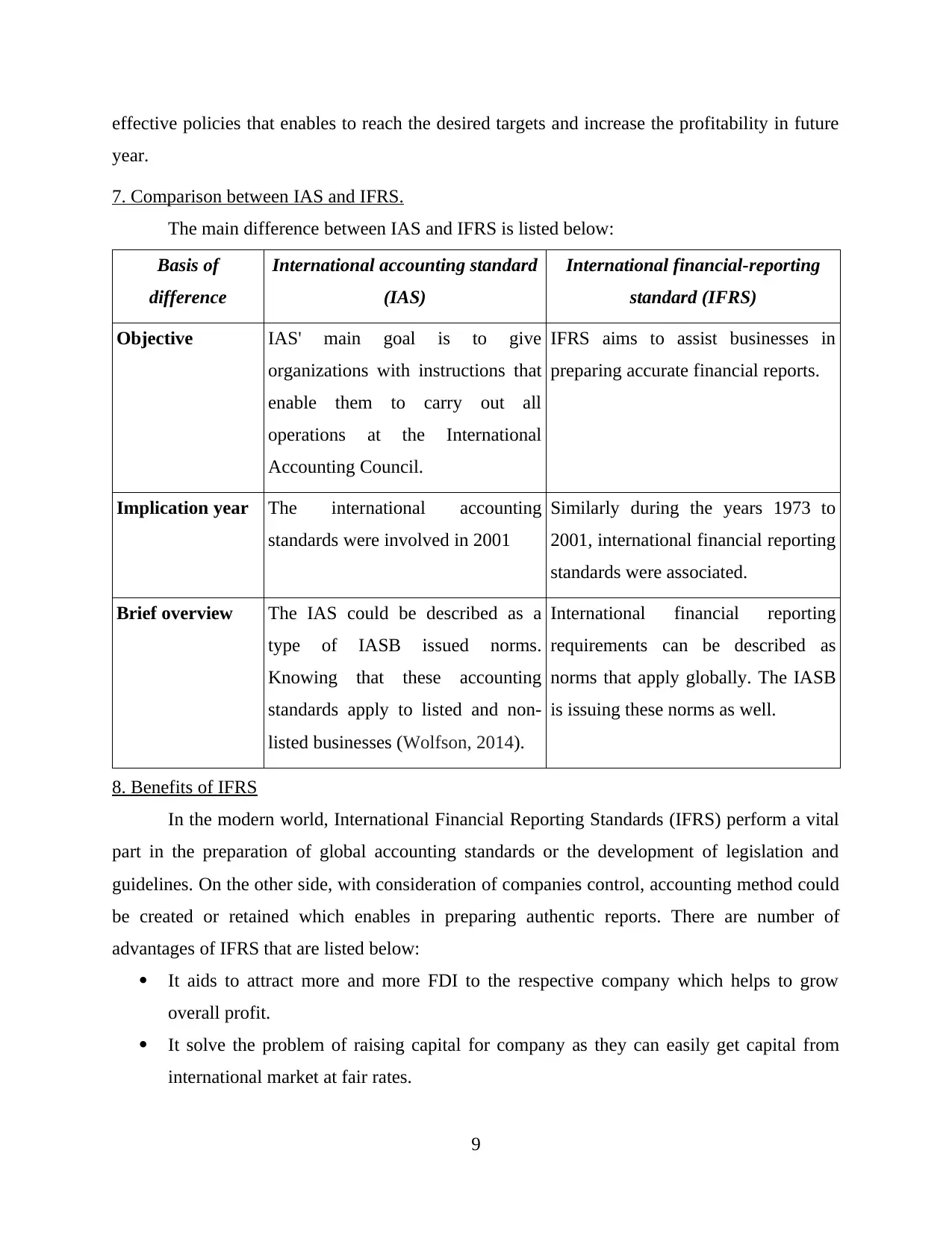
effective policies that enables to reach the desired targets and increase the profitability in future
year.
7. Comparison between IAS and IFRS.
The main difference between IAS and IFRS is listed below:
Basis of
difference
International accounting standard
(IAS)
International financial-reporting
standard (IFRS)
Objective IAS' main goal is to give
organizations with instructions that
enable them to carry out all
operations at the International
Accounting Council.
IFRS aims to assist businesses in
preparing accurate financial reports.
Implication year The international accounting
standards were involved in 2001
Similarly during the years 1973 to
2001, international financial reporting
standards were associated.
Brief overview The IAS could be described as a
type of IASB issued norms.
Knowing that these accounting
standards apply to listed and non-
listed businesses (Wolfson, 2014).
International financial reporting
requirements can be described as
norms that apply globally. The IASB
is issuing these norms as well.
8. Benefits of IFRS
In the modern world, International Financial Reporting Standards (IFRS) perform a vital
part in the preparation of global accounting standards or the development of legislation and
guidelines. On the other side, with consideration of companies control, accounting method could
be created or retained which enables in preparing authentic reports. There are number of
advantages of IFRS that are listed below:
It aids to attract more and more FDI to the respective company which helps to grow
overall profit.
It solve the problem of raising capital for company as they can easily get capital from
international market at fair rates.
9
year.
7. Comparison between IAS and IFRS.
The main difference between IAS and IFRS is listed below:
Basis of
difference
International accounting standard
(IAS)
International financial-reporting
standard (IFRS)
Objective IAS' main goal is to give
organizations with instructions that
enable them to carry out all
operations at the International
Accounting Council.
IFRS aims to assist businesses in
preparing accurate financial reports.
Implication year The international accounting
standards were involved in 2001
Similarly during the years 1973 to
2001, international financial reporting
standards were associated.
Brief overview The IAS could be described as a
type of IASB issued norms.
Knowing that these accounting
standards apply to listed and non-
listed businesses (Wolfson, 2014).
International financial reporting
requirements can be described as
norms that apply globally. The IASB
is issuing these norms as well.
8. Benefits of IFRS
In the modern world, International Financial Reporting Standards (IFRS) perform a vital
part in the preparation of global accounting standards or the development of legislation and
guidelines. On the other side, with consideration of companies control, accounting method could
be created or retained which enables in preparing authentic reports. There are number of
advantages of IFRS that are listed below:
It aids to attract more and more FDI to the respective company which helps to grow
overall profit.
It solve the problem of raising capital for company as they can easily get capital from
international market at fair rates.
9
⊘ This is a preview!⊘
Do you want full access?
Subscribe today to unlock all pages.

Trusted by 1+ million students worldwide
1 out of 16
Related Documents
Your All-in-One AI-Powered Toolkit for Academic Success.
+13062052269
info@desklib.com
Available 24*7 on WhatsApp / Email
![[object Object]](/_next/static/media/star-bottom.7253800d.svg)
Unlock your academic potential
Copyright © 2020–2025 A2Z Services. All Rights Reserved. Developed and managed by ZUCOL.





